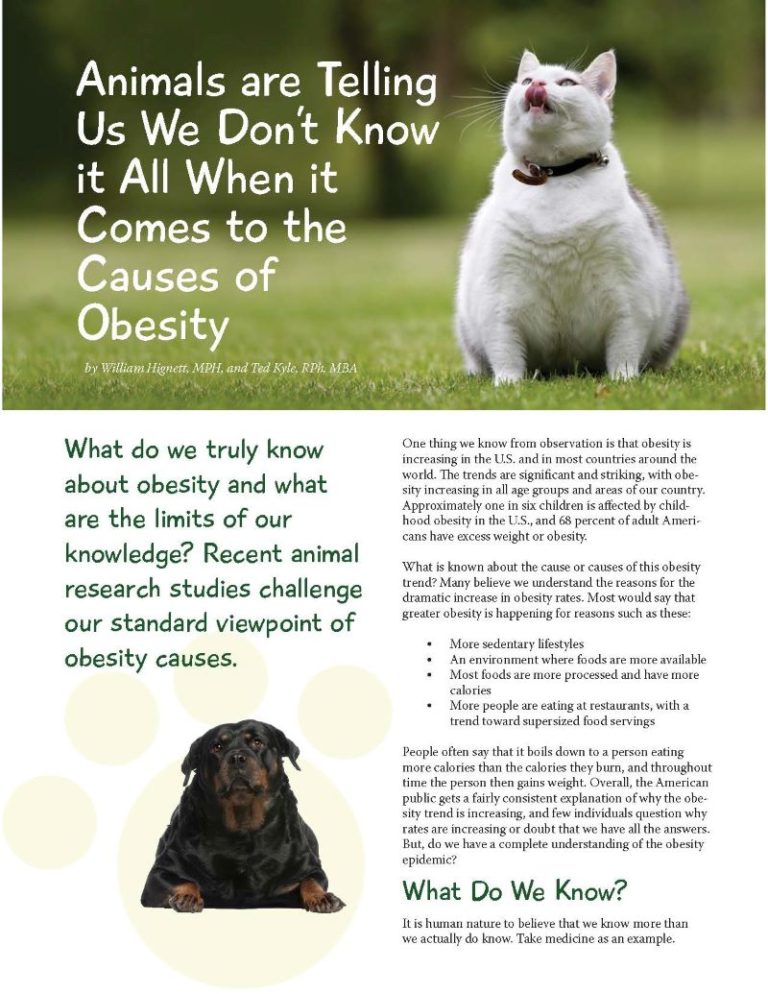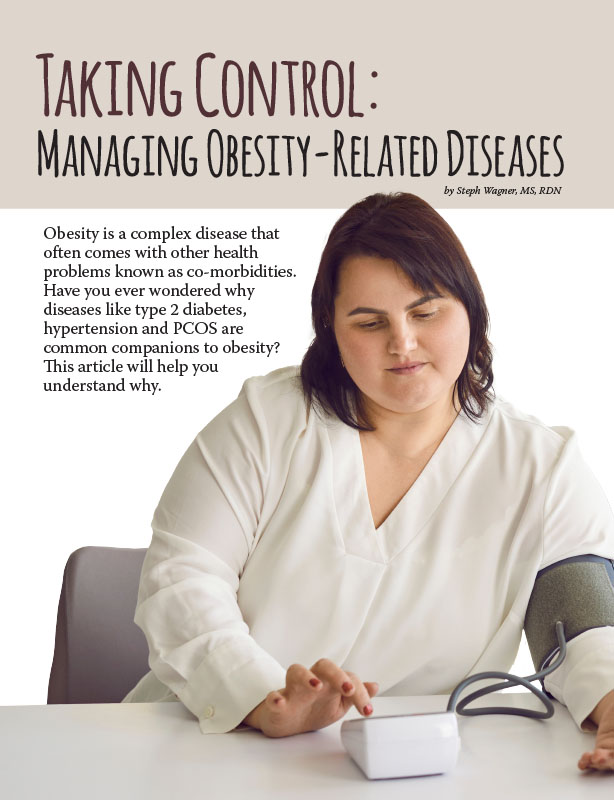Animals are Telling Us We Don’t Know it All When it Comes to the Causes of Obesity


by William Hignett, MPH, and Ted Kyle, RPh, MBA
Fall 2012
What do we truly know about obesity and what are the limits of our knowledge? Recent animal research studies challenge our standard viewpoint of obesity causes.
One thing we know from observation is that obesity is increasing in the U.S. and in most countries around the world. The trends are significant and striking, with obesity increasing in all age groups and areas of our country. Approximately one in six children is affected by childhood obesity in the U.S., and 68 percent of adult Americans have excess weight or obesity.
What is known about the cause or causes of this obesity trend? Many believe we understand the reasons for the dramatic increase in obesity rates. Most would say that greater obesity is happening for reasons such as these:
- More sedentary lifestyles
- An environment where foods are more available
- Most foods are more processed and have more calories
- More people are eating at restaurants, with a trend toward supersized food servings
People often say that it boils down to a person eating more calories than the calories they burn, and throughout time the person then gains weight. Overall, the American public gets a fairly consistent explanation of why the obesity trend is increasing, and few individuals question why rates are increasing or doubt that we have all the answers. But, do we have a complete understanding of the obesity epidemic?
What Do We Know?
It is human nature to believe that we know more than we actually do know. Take medicine as an example. Patients often do not question whether their physicians and other health professionals are up-to-date and have full knowledge of conditions and treatments. Yet, recall that we knew next to nothing about cancer in the 1950s, and medical practitioners at one time treated ulcers with bland diets and antacids.
 There is a staggering amount of clinical and scientific information today, and with globalization and rapid technology changes, information is exploding. As science and medicine advance, more is learned, resulting in changes in practices and knowledge. Clinical guidelines are updated and adjusted every few years for most diseases. Patients, for example, who receive a beta blocker and a daily aspirin after a heart attack fare much better than those who do not – an insight from the last few decades. The goal of treatment for patients with diabetes now is tight blood sugar control. Cigarettes are now known to cause heart problems, lung problems, cancer, and other health complications. But, in the 1950’s little was known definitely about diabetes, or about cigarettes.
There is a staggering amount of clinical and scientific information today, and with globalization and rapid technology changes, information is exploding. As science and medicine advance, more is learned, resulting in changes in practices and knowledge. Clinical guidelines are updated and adjusted every few years for most diseases. Patients, for example, who receive a beta blocker and a daily aspirin after a heart attack fare much better than those who do not – an insight from the last few decades. The goal of treatment for patients with diabetes now is tight blood sugar control. Cigarettes are now known to cause heart problems, lung problems, cancer, and other health complications. But, in the 1950’s little was known definitely about diabetes, or about cigarettes.
Science works to gain a better understanding of the unknown. At the University of Arizona College of Medicine, a curriculum on medical ignorance helps students realize the shifting domains of ignorance, uncertainty and the unknown. We, as consumers of healthcare, also need to remember that mistaken concepts from the past suggest that we should accept today’s facts with caution. This approach, of course, applies to obesity. How firm are the facts and concepts about the cause of the increasing rate of obesity in the last half century?
Let’s Look at the Facts and Concepts
Recent animal research studies challenge our standard viewpoint of obesity causes. According to a recent review by German, “most investigators agree that, as in humans, the incidence of obesity in the pet population is increasing.” Obesity is a growing problem for dogs and cats, and in 2007 there was a 19 percent increase in claims related to obesity. The Association for Pet Obesity Prevention estimates that 54 percent of dogs and cats have excess weight or obesity in the U.S., which the association estimates would be 93 million animals. Some people may be skeptical of pet obesity, believing owners may simply be overfeeding their dogs and cats. Yet, obesity estimates in the tens of millions should cause at least a raised eyebrow.
A 2010 study in the Proceedings of the Royal Society B: Biological Sciences provides even more rigorous evidence that something is happening across mammals, which indicates that the obesity rate increase is not confined to humans. This study was conducted because little is known about whether similar increases in obesity have occurred in animals inhabiting human-influenced environments. The authors examined samples collectively, consisting of more than 20,000 animals from 24 populations of animals within eight species, living with or around humans in industrialized countries. The researchers followed the animals’ percentage weight gain per decade.
The results of the study found that both the percentage increase in body weight and the odds of an animal being overweight in any given population showed a strong increasing trend. Although the shift was only significant in less than half of the groups evaluated individually, it was highly significant when all of the animal groups’ results were lumped together. The study looked at more than 20,000 animals and found an increasing trend in obesity in lab mice and rats, chimps, marmosets, rhesus monkeys, feral rats, domestic dogs and cats and other animals. With respect to percent weight change, in 24 out of 24 time periods the trends for weight gain were increasing.
What’s Causing Weight Gain in Animals?
What caused this increase in obesity in the studied animals? Perhaps for the feral rats, the greater than 40 percent jump in body weight came from scavenging on the streets of Baltimore, and it reflected the increased richness of their diet from more calorie-dense garbage. Unknown factors might be involved in the other animal populations, many of them lab animals on strict diets. Could it be that toxins which disrupt the endocrine system are causing obesity, or perhaps particular pathogens might be having a widespread effect on the metabolism of mammals?
At least one study suggests that a virus is involved in stimulating weight gain. Human adenovirus-36 (Adv-36) increases the fat in adipose tissue in chickens, mice and non-human primates. The role of Adv-36 in human obesity is unknown, but data from the study in the International Journal of Obesity found that the prevalence of Adv-36 antibodies is almost three-fold higher in people with obesity compared to others.
Although the animal data does not show causation of factors associated with obesity trends in animals, it points out a lack of knowledge. As Stuart Firestein points out in his new book, Ignorance: How It Drives Science, more often than not, science is looking for a black cat in a dark room, when a black cat might not even be in that room. But it is the “not knowing” that gets researchers into the labs and in the field working long hours to answer tough questions. Hunger for knowledge is the driving force of science. With billions spent on scientific research – $420 billion annually for U.S. government support of scientific research and education, with an additional $700 billion annually for corporate scientific research – should we be so accepting about assumptions regarding what causes obesity and other obesity questions?
Summary
Animal research is telling us that we know far from everything about obesity. In fact, we still have much to learn about the many facets of obesity. Perhaps it is time to attack this lack of knowledge with a vigorous effort such as in the 1960’s with the “war on cancer,” with an all-out commitment to learn more before the U.S. healthcare system is crushed by the costs of obesity and its many related medical conditions.
About the Authors:
William Hignett, MPH, is a disease management expert with a public health and a business background.
Ted Kyle, RPh, MBA, is a pharmacist and health marketing expert and is also a member of the OAC National Board of Directors.
by Steph Wagner, MS, RDN Spring 2024 Obesity is a complex disease that often comes with other…
Read Articleby Sarah Muntel, RD Spring 2024 Spring has sprung, bringing sunnier and warmer days! For many, this…
Read Articleby Yelena Kibasova Spring 2024 The fitness world is evolving, with new trends and innovations that promise…
Read Article









